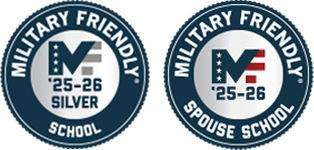Background
This guidance document provides guidelines on selection of Personal Protective Equipment (PPE) for protection from electric arc flash from equipment for which detailed arc hazard analysis has not been performed. This guidance applies to situations in which staff may be exposed to arc flash from high voltage switches or live unguarded electrical wires, parts or equipment with voltages above 50 Volts. PPE is not required when in proximity to electrical equipment in enclosed panels with no exposed connectors, where electrical work is not being performed and where no high voltage switch is being operated.
An arc flash may occur when electrical current "short circuits," that is, flows from energized wires or equipment to ground, or between energized wires or equipment with different phases or potential. An arc flash may also occur during movement of energized electrical contactors, such as switches. The arc flash creates electrically conductive superheated plasma that can reach temperatures of 5000° F and above. Occurring in a fraction of a second, it produces a brilliant flash, intense heat, and a shock wave. The magnitude of the energy and other factors will determine the severity of the arc flash. With sufficient energy, an arc flash may become an arc blast producing a dangerous shock wave.
This guidance is derived from the National Fire Protection Association's (NFPA) recommended standard NFPA 70E, Standard for Electrical Safety in the Workplace. This document will summarize key provisions of NFPA 70E as they apply to work conducted by SUNY NP FOC employees. Refer to NFPA 70E for additional information.
This guidance should be used unless there is a detailed arc hazard analysis and Hazard Mitigation Plan that has calculated arc flash energy and established PPE requirements for the specific equipment being worked on. Equipment has started to be labeled with a label such that pictured below (note: This is an on going labeling process by FOC and not all equipment has been labeled as of today).
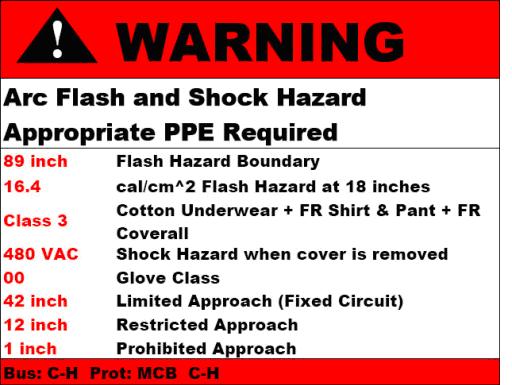
Definitions
Arc Rating [NFPA 70E] - The maximum incident energy resistance demonstrated by a material (or a layered system of materials) prior to break open or at the onset of a second-degree skin burn. Arc rating is normally expressed in cal/cm2.
Boundaries:
Limited Approach Boundary - a shock protection boundary to be crossed by only qualified persons (at a distance from a live part) which is not to be crossed by unqualified persons unless escorted by a qualified person". The limited approach boundary is the minimum distance from the energized item where unqualified personnel may safely stand. No untrained personnel may approach any closer to the energized item than this boundary.
Restricted Approach Boundary-A shock protection boundary to be crossed by only qualified persons (at a distance from a live part) which, due to its proximity to a shock hazard, requires the use of shock protection techniques and equipment when crossed. To cross the Restricted Approach Boundary into the Restricted Space, the qualified person, who has completed required training, must wear appropriate personal protective equipment (PPE). Also, he must have a written approved plan for the work that they will perform and plan the work to keep all parts of the body out of the Prohibited Space. This boundary is determined from NFPA Table 2-1.3.4 (2000 Edition) and is based on the voltage of the equipment.
Prohibited Approach Boundary-A shock protection boundary to be crossed by only qualified persons (at a distance from a live part) which, when crossed by a body part or object, requires the same protection as if direct contact is made with a live part. Only qualified personnel wearing appropriate personal protective equipment (PPE), having specified training to work on energized conductors or components, and a documented plan justifying the need to perform this work may cross the boundary and enter the Prohibited Space. Therefore, personnel must obtain a risk assessment before the prohibited boundary is crossed. This boundary is determined by NFPA 70E Table 2-1.3.4 (2000 Addition) and is based upon the voltage of the equipment.
Circuit Breaker [NFPA 70E] - A device designed to open and close a circuit by non-automatic means and to open the circuit automatically when a predetermined over current occurs without damage to itself when properly applied within its rating.
Dead Front [NFPA 70E] - Without live parts exposed to a person on the operating side of the equipment.
Disconnecting Means [NFPA 70E] - A device, or group of devices, or other means by which the conductors of a circuit can be disconnected from their source of supply.
Electrical Hazard [NFPA 70E] - A dangerous condition such that contact or equipment failure can result in electric shock, arc flash burn, thermal burn or blast.
Exposed (as applied to live parts) [NFPA 70E] - Capable of being inadvertently touched or approached nearer than a safe distance by a person. It is applied to parts that are not suitably guarded, isolated, or insulated.
Exposed (to arc flash hazard) - Within the flash protection boundary during work activities on or close to unguarded energized electric wires or equipment, or activation of unguarded energized electrical switches. This includes opening of electrical enclosures.
Flash Hazard [NFPA 70E] - A dangerous condition associated with the release of energy caused by an electric arc.
Flash Protection Boundary [NFPA 70E] - An approach limit at a distance from exposed live parts within which a person could receive a second degree burn if an electrical arc flash were to occur.
Entry into the Flash Protection Boundary occurs when the face, head or trunk of the person crosses the boundary. Within this boundary workers are required to wear appropriate PPE. [Note: if hands cross the boundary, PPE is required on the hands and arms]
Flash Suit [NFPA 70E] - A complete system of fire retardant clothing and equipment that covers the entire body, except for the hands and feet including pants, jacket, and bee-keeper type hood fitted with a face shield.
Electrical protective gloves are categorized by the level of voltage protection provided, which are rated by Class. Ozone resistance is noted by Type. Type I gloves are not ozone resistant. Type II gloves are resistant to ozone.Class 00 - 500 Volts MaximumClass 0 - 1,000 Volts MaximumClass 1 - 7,500 Volts MaximumClass 2 - 17,000 Volts MaximumClass 3 - 26,5000 Volts MaximumClass 4 - 36,000 Volts Maxium
Opening Door - To move (as a breaker box door) from a closed position by making available for entry, by turning back (as a barrier) or by removing (as a panel cover or obstruction).
Qualified Person [NFPA 70E] - One who has skills and knowledge related to the construction and operation of the electrical equipment and installations and has received safety training on the hazards involved.
Working On (live parts) [NFPA 70E] - Coming into contact with live parts greater than 50 Volts with the hands, feet, or other body parts, with tools, probes, or with test equipment, regardless of the PPE a person is wearing.
Responsibilities
Only Qualified Person(s) are allowed to work on electrical equipment.
Supervisors of Qualified Persons shall ensure that employees comply with the requirements set forth in this guidance, including that required PPE is available and used appropriately by employees, that employees are assigned work for which they are qualified, and that appropriate training has been conducted for staff to perform their jobs safely.
Individuals opening or exposing energized electrical wires or equipment are responsible for assessing the requirements of this guideline and taking appropriate measures to protect themselves and others from potential arc flash hazards.
Employees will perform only those tasks for which they are qualified, shall understand the basic principles of high voltage electricity, hazardous energy control and electrical safety procedures. Employees shall use the proper tools and required PPE, and shall request supplemental training and information whenever necessary.
See the SUNY NP Personal Protective Equipment procedure for a complete listing of responsibilities associated with any PPE.
Safeguarding Electrical Parts and Equipment
Whenever possible, live parts to which an employee might be exposed shall be put into an electrically safe work condition before an employee works on or near them. This may be done by de-energizing and locking out, insulating or enclosing.
When safeguarding is not feasible, precautions for protection from arc flash and electric shock are required.
"Dead Front" Equipment
Dead front equipment is equipment within enclosures or panels without live parts exposed to a person on the operating side of the equipment. This includes disconnects, control panels, switches, breakers, and motor controls within enclosures with the doors closed and secured.
Arc flash PPE is not required when operating this equipment. It is a recommended practice for electricians and other employees who commonly operate this equipment to wear non-melting clothes and safety glasses.
It is also a good practice when an employee is switching disconnect switches for him/her to stand to the hinge side of door, so that he/she is out of the direct line of fire if a catastrophic fault occurs when the switch is operated. Further protection would be afforded by taking a deep breath and facing away from the switch, before throwing the switch.
Exposure to Arc Flash
The potential for arc flash exists when there is a potential for an electrical current to short circuit. A short circuit occurs when current flows from energized wires or equipment to ground, or between energized wires or equipment with different phases or potential. An arc flash may also occur during movement of energized electrical contactors.
Exposure to an arc flash hazard occurs when a person is close enough to a potential source of arc flash that he/she may be injured if there is no protection such as an electrical enclosure or barrier.
Tasks such as opening electrical panels can result in an exposure to an arc flash hazard and may require protection. Servicing, maintenance and testing of energized circuits, or within equipment with energized circuits, creates an additional risk for arc flash through accidental contact of tools or equipment with un-insulated energized wires or parts.
Hazard distance requiring the use of PPE is defined by the Flash Protection Boundary.
Flash Protection Boundary
The Flash Protection Boundary is the distance from a potential source of arc flash within which arc flash PPE is required. Inside this boundary, it is estimated that a person could receive a second degree burn if an electrical arc flash were to occur. Entry into the Flash Protection Boundary occurs when the face, head or trunk of the person crosses the boundary.
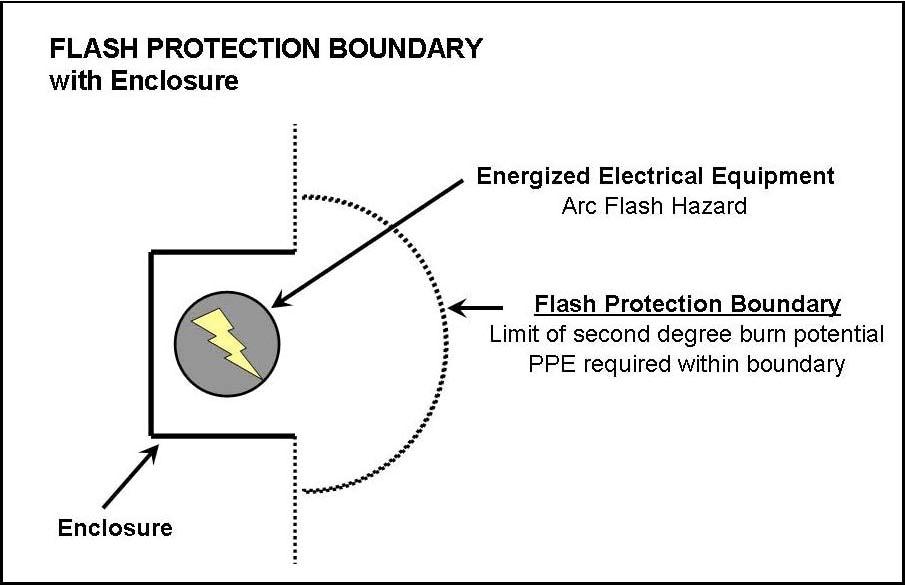
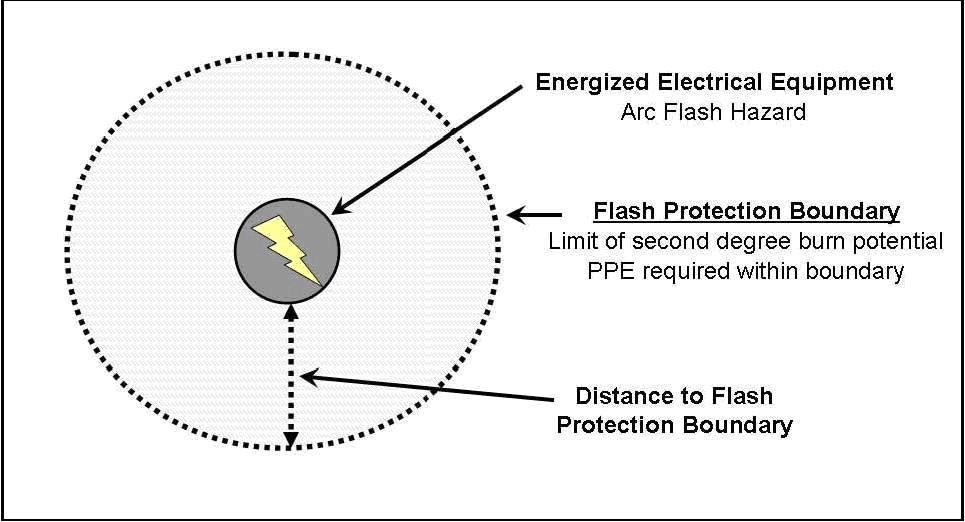
Equipment-specific arc flash boundaries may depend upon numerous factors such as available fault level and trip characteristics of the upstream protective device, as determined in an arc hazard analysis. Default Flash Protection Boundaries are provided in this table based on the most Conservative assumptions in NFPA 70E and may be used if there are no detailed arc hazard analyses and equipment-specific Hazard Mitigation Plan.
| Arc Location | System Voltage | Flash Protection Boundary (Feet) |
| Arc in air | 200-600V | 4 |
| Arc in enclosure | 200-600V | 10 |
| Arc in enclosure | 600V and up | 20 |
Arc in air means unenclosed, so that flash energy is dispersed in all directions. This type of exposure may occur when an employee is testing live wiring outside of an enclosure.
Most exposures will occur with equipment in enclosures. The enclosure will direct the arc flash energy in the direction of the opening. This protects people away from the opening but increases the energy directed towards anyone in front of the opening.
Personal Protective Equipment (PPE) Classifications
For all work involving potential exposure to energized unguarded or un-insulated electrical equipment, non-melting clothing must be worn. Non-melting clothes are natural fibers such as cotton and wool. Synthetic clothing can melt and burn rapidly when exposed to heat or flame and can increase burn injuries. Electrical safety programs will also generally prohibit employees from wearing metallic jewelry and recommend not wearing clothing with metal closures (e.g., zippers, snaps).
In addition to non-melting clothing, the appropriate level of PPE must be worn for tasks in which exposure to an arc flash hazard within the flash protection boundary is possible.
Flame resistant clothing may be a treated fabric or a flame resistant fabric such as Nomex. PPE is designated according to Arc Rating. The higher the energy exposure, the higher the Arc Rating expressed in cal/cm2. Typically, Flash Suits and Flash Hoods are rated on the inside tag, expressing what the Arc Rating is for that garment.
Glove Class
Electrical Glove Classification specified on Arc Flash Label:
Electrical protective gloves are categorized by the level of voltage protection provided, which are rated by Class. Ozone resistance is noted by Type. Type I gloves are not ozone resistant. Type II gloves are resistant to ozone.
Class 00 - 500 Volts Maximum
Class 0 - 1,000 Volts Maximum
Class 1 - 7,500 Volts Maximum
Class 2 - 17,000 Volts Maximum
Class 3 - 26,5000 Volts Maximum
Class 4 - 36,000 Volts Maximum
PPE Level as specified in tables and Arc FLASH labels (Gloves separated above)
The following levels of protective clothing are specified in NFPA 70E Table 130.7(C)(10) for protection from arc flash.
Level 0 -
Non-Melting Long Sleeve Shirt;
Non-Melting Long Pants.
Safety Glasses.
Gloves see table above
Level 1 -
Minimum Arc Rating 4 cal/cm2 .
Flame Resistant (FR) Long Sleeve Shirt;
FR or Denim Long Pants;
FR Coveralls may be used instead of FR Shirt and Pants.
Hard Hat (Class E),
Arc Rated Face shield,
Leather Work Shoes.
Gloves See table above
Level 2 -
Minimum Arc Rating 8 cal/cm2
Cotton Underwear plus FR Long Sleeved Shirt;
FR or Denim Long Pants;
FR Coveralls may be used instead.
Hard Hat (Class E),
Safety Glasses or Goggles,
Arc Rated Flash Hood (20 cal/cm2 or equivalent) or Arc Rated Face Shield, Hearing Protection,
Leather Work Shoes.
Gloves see table above
Level 3 -
Minimum Arc Rating 25 cal/cm2 .
Cotton Underwear plus FR Long Sleeved Shirt;
FR or Denim Long Pants; plus FR Coveralls.
Hard Hat (Class E),
Safety Glasses or Goggles,
Arc Rated Flash Suit w/ Hood (40 cal/cm2 or equivalent),
Hearing Protection,
Leather Work Shoes.
Gloves see table above
Level 4 -
Minimum Arc Rating 40 cal/cm2 .
Cotton Underwear plus FR Long Sleeved Shirt;
FR or Denim Long Pants; plus Multi-Layer Arc Rated Flash Suit
(100 cal/cm2 or equivalent).
Hard Hat (Class E),
Safety Glasses or Goggles,
Arc Rated Flash Suit Hood (100 cal/cm2 or equivalent),
Hearing Protection,
Leather Work Shoes.
Gloves see table above
Inspection, Maintenance, Cleaning and Storage of PPE
PPE may be individually assigned or available to a group.
For individually assigned PPE, the person to whom the equipment is assigned is responsible for inspection, maintenance and storage of the PPE.
For group equipment, such as 100 cal/cm2 suits, a person shall be assigned responsibility for inspection, maintenance and storage of the equipment.
The user must inspect all PPE prior to and after each use for damage and defects. Any damage, defects, or problems with the equipment must be reported to the Responsible Individual.
SUNY NP FOC will follow manufacturer's recommendations for laundering protective clothing and will provide for special care of treated fabrics, when required.
SUNY NP FOC will follow manufacturer's recommendations for cleaning and storing of other protective equipment. Storage bags and designated, secure, readily accessible storage areas are recommended.
Low Voltage Tasks (less than 600 Volts)
The flash protection boundary (before equipment-specific assessment) for exposed equipment less than 600 Volts is 10 feet. Arc Flash PPE is for exposure within this boundary.
PPE may be selected based on the attached Low Voltage Hazard/Risk Classifications Table (Appendix B) and the PPE levels specified in Section 8, or the following standard clothing may be used.
Standard clothing for all Level 1 and Level 2 tasks (see Low Voltage Hazard/Risk Classifications) is:
> Minimum Arc Rating 8 cal/cm2 .
> Cotton Underwear plus FR Long Sleeved Shirt and FR or Denim Long Pants; FR Coveralls may be used instead of shirt and pants.
> Hard Hat (Class E), Safety Glasses or Goggles, Arc Rated Flash Hood (20 cal/cm2 or equivalent) or Arc Rated Face Shield, Hearing Protection, Gloves see table and Leather Work Shoes.
The following low voltage tasks require Level 3 clothing (see other section for description of level 3 PPE):
> Insertion or removal of starter buckets from MCC.
> Insertion or removal (racking) of circuit breakers, with doors open.
> Removal of bolted covers to expose bare, energized parts in switchgear (<600V).
High Voltage Tasks (greater than 600 Volts)
The interim flash protection boundary (i.e., before equipment-specific assessment) for high voltage tasks is 20 feet. Arc Flash PPE must be worn within this boundary.
PPE may be selected based on the attached High Voltage Hazard/Risk Classifications Table (Appendix C) and the PPE levels specified in Section 8, or the following standard clothing may be used.
Standard clothing for all Level 3 and Level 4 tasks (see High Voltage Hazard/Risk Classifications) is:
> Minimum Arc Rating 40 cal/cm2 .
> Cotton Underwear plus FR Long Sleeved Shirt and FR or Denim Long Pants; Plus Multi-Layer Arc Rated Flash Suit (100 cal/cm2 or equivalent).
> Hard Hat (Class E), Safety Glasses or Goggles, Arc Rated Flash Suit Hood (100 cal/cm2 or equivalent), Hearing Protection, Gloves see table, Leather Work Shoes.
Selection of PPE
Training and authorization must be appropriate for the level of energy and type of PPE being used. As an example, a person trained and authorized for 480 volt work may not be sufficiently trained or authorized for 4160 volt work.
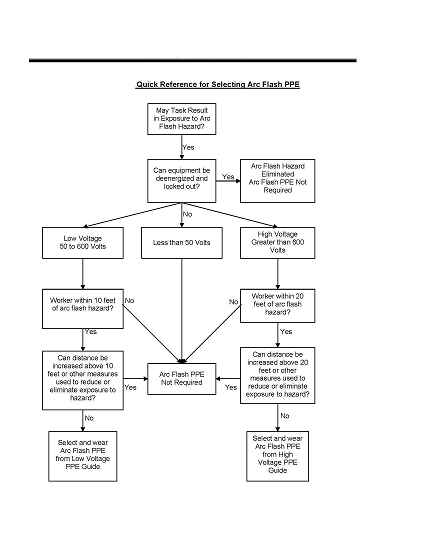
Appendix B - Low Voltage (Less Than or Equal to 600 Volts)
Hazard/Risk Category Classifications Assumes equipment is energized and work is done within the Flash Protection Boundary Source NFPA 70E Table 130.7(C)(9)(a).
| EQUIPMENT | TASK | PPE LEVEL |
|
Panel boards rated 240V and below |
Circuit breaker (CB) or fused switch operation with covers on | 0 |
| CB or fused switch operation with covers off | 1 | |
| Work on energized parts, including voltage testing | 1 | |
| Remove/install CBs or fused switches | 1 | |
| Removal of bolted covers (to expose bare, energized parts) | 1 | |
| Opening hinged covers (to expose bare, energized parts) | 1 | |
|
Panel boards or
|
CB or fused switch operation with covers on | 0 |
| CB or fused switch operation with covers off | 1 | |
| Work on energized parts, including voltage testing | 2* | |
|
600 V Class Motor |
CB or fused switch or starter operation with enclosure doors open |
0 |
| Reading a panel meter while operating a meter switch | 0 | |
|
CB or fused switch or starter operation with enclosure doors |
1 | |
| Work on energized parts, including voltage testing | 2* | |
| Work on control circuits with energized parts 120V or below, exposed |
0 | |
| Work on control circuits with energized parts > 120V, exposed |
2* | |
| Insertion or removal of individual starter "buckets" from MCC - Note 4 |
3 | |
| Application of safety grounds, after voltage test. Removal of bolted covers (to expose bare, energized parts) |
2* | |
| Opening hinged covers to expose bare, energized parts | 1 | |
| CB or fused switch operation with enclosure doors closed | 0 | |
| Reading a panel meter while operating a meter switch | 0 | |
| CB or fused switch operation with enclosure doors open | 1 | |
| 600 V Class Switchgear (with power circuit breakers or fused switches) |
Work on energized parts, including voltage testing | 2* |
| Work on control circuits with energized parts 120 V or below, exposed |
0 | |
| Work on control circuits with energized parts > 120 V, exposed |
2* | |
| Insertion or removal (racking) of CBs from cubicles, doors open |
3 | |
| Insertion or removal (racking) of CBs from cubicles, doors closed |
2 | |
| Application of safety grounds, after voltage test | 2* | |
| Removal of bolted covers (to expose bare, energized parts) | 3 | |
| Opening hinged covers (to expose bare, energized parts) | 2 | |
| Other 600 V Class (277 V through 600 V, nominal equipment) |
Lighting or small power transformers (600 V, maximum) - Removal of bolted covers (to expose bare, energized parts) |
2* |
| Lighting or small power transformers (600 V, maximum) - Opening hinged covers (to expose bare, energized parts) |
1 | |
| Lighting or small power transformers (600 V, maximum) - Work on energized parts, including voltage testing |
2* | |
| Lighting or small power transformers (600 V, maximum) - Application of safety grounds, after voltage test |
2* | |
| Revenue meters (kW-hour, at primary voltage and current) - Insertion or removal |
2* | |
| Revenue meters (kW-hour, at primary voltage and current) - Cable trough or tray cover removal or installation |
1 | |
| Revenue meters (kW-hour, at primary voltage and current)- Miscellaneous equipment cover removal or installation |
1 | |
| Revenue meters (kW-hour, at primary voltage and current)- Work on energized parts, including voltage testing |
2* | |
| Revenue meters (kW-hour, at primary voltage and current)- Application of safety grounds, after voltage test |
2* |
Notes: 2* means that a double-layer switching hood and hearing protection are required for this task in addition to the other Hazard/Risk Category 2 requirements
Appendix C - High Voltage (Greater than 600 Volts)
Hazard/Risk Category Classifications
Assumes equipment is energized and work is done within the Flash Protection Boundary Source NFPA 70E Table 130.7(C)(9)(a)
| Equipment | Task | PPE |
|
NEMA E2 (fused
contactor) Motor Starters 2.3 kV - 7.2 kV |
Operation with enclosure doors closed | 0 |
| Reading a panel meter while operating a meter switch | 0 | |
| Operation with enclosure doors open | 2* | |
| Work on energized parts, including voltage testing | 3 | |
| Work on control circuits with energized parts 120 V or below, exposed |
0 | |
| Work on control circuits with energized parts > 120 V, exposed |
3 | |
| Insertion or removal (racking) of starters from cubicles, doors open |
3 | |
| Insertion or removal (racking) of starters from cubicles, doors closed |
2 | |
| Application of safety grounds, after voltage test | 3 | |
| Removal of bolted covers (to expose bare, energized parts) |
4 | |
| Opening hinged covers (to expose bare, energized parts) | 3 | |
| Metal Clad Switchgear 1 kV and above |
CB or fused switch operation with enclosure doors closed | 2 |
| Reading a panel meter while operating a meter switch | 0 | |
| CB or fused switch operation with enclosure doors open | 4 | |
| Work on energized parts, including voltage testing | 4 | |
| Work on control circuits with energized parts 120 V or below, exposed |
2 | |
| Removal of bolted covers (to expose bare, energized parts) | 4 | |
| Opening hinged covers (to expose bare, energized parts) | 3 | |
| Opening voltage transformer or control power transformer compartments | 4 | |
| Other Equipment 1 kV and above Metal clad load interrupter switches, fused or unfused |
Switch operation, doors closed | 2 |
| Work on energized parts, including voltage testing | 4 | |
| Removal of bolted covers (to expose bare, energized parts) | 4 | |
| Opening hinged covers (to expose bare, energized parts) | 3 | |
| Outdoor disconnect switch operation (hook stick operated) | 3 | |
| Outdoor disconnect switch operation (gang operated, from grade) | 2 | |
| Insulated cable examination, in manhole or other confined space | 4 | |
| Insulated cable examination, in open area | 2 |
Notes: 2* means that a double-layer switching hood and hearing protection are required for this task in addition to the other Hazard/Risk Category 2 requirements
Kyle Mungavin, Assistant Director
Service Building, Room 217
(845) 257-3310
